The iPhone 7 and iPhone 7 Plus Review: Iterating on a Flagship
by Joshua Ho & Brandon Chester on October 10, 2016 8:00 AM EST- Posted in
- Smartphones
- Apple
- Mobile
- iOS
- iOS 10
- iPhone 7
- iPhone 7 Plus
System Performance
Section by Brandon Chester
At the heart of a smartphone lies the SoC. While there's now an increasingly common belief that specifications don't matter, the truth of the matter is that almost all of the software features that users now take for granted in a smartphone have only been made possible by the continued improvements in hardware performance. Modern smartphones with high resolution displays and complex interfaces would not exist if the available CPU and GPU processing power hadn't advanced as much as it has. On top of that, performance is something of a gating factor for software development, as the innovation that happens in software has to happen within the boundaries of what can be done with the hardware. Specifications in a smartphone actually matter quite a lot, even if the user isn't actively aware of all the individual components that make up their smartphone's SoC.
With the iPhone 7 Apple doesn't have the benefit of a new major process node to help improve performance. Any improvements will be the result of architectural improvements, as well as improvements that have been made to TSMC's 16nm process since the release of the Apple A9, which was Apple's first FinFET SoC. It's important to note that one of the goals of A10 Fusion is improving dynamic range, so the focus isn't solely on improving performance. However, device performance seemingly must improve with each generation, and Apple is advertising a 40% improvement in CPU performance and a 50% improvement in GPU performance with A10 Fusion compared to A9.
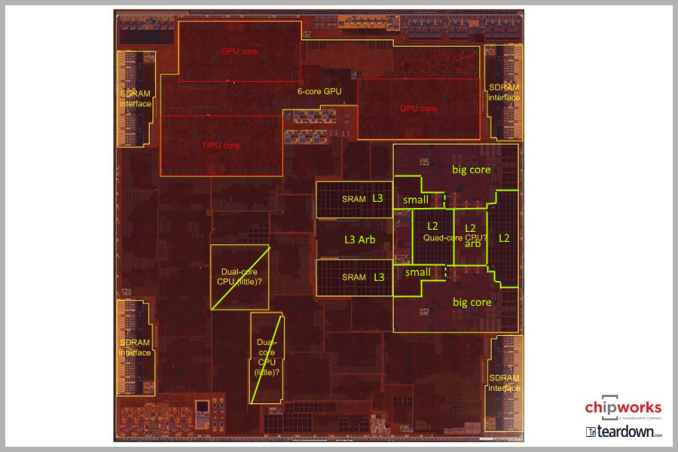
A10 Fusion's Floorplan (Special thanks to Chipworks)
While an in-depth look at A10 Fusion will have to wait until our seperate technology deep dive, we can still take a look at how performance has changed at a higher level. A10 Fusion's peak frequency is 2.3GHz, up from 1.8GHz on A9. This gives a theoretical improvement of 28% on its own, and the remainder will have to come from improvements to the architecture in Apple's (big) Hurricane cores. Based on our testing so far, Hurricane is not radically different from Twister (A9), but Apple has been making some optimizations. Meanwhile it should be noted that while A10 technically has four CPU cores – the two Hurricane cores and the two smaller cores – this is not a heterogeneous design, and only two cores are active at once. So for the purposes of high performance benchmarking, this means we're benchmarking the big cores nearly exclusively.
Anyhow, we've run our standard suite of benchmarks on the iPhone 7 and 7 Plus to see if A10 Fusion stands up Apple's performance claims.
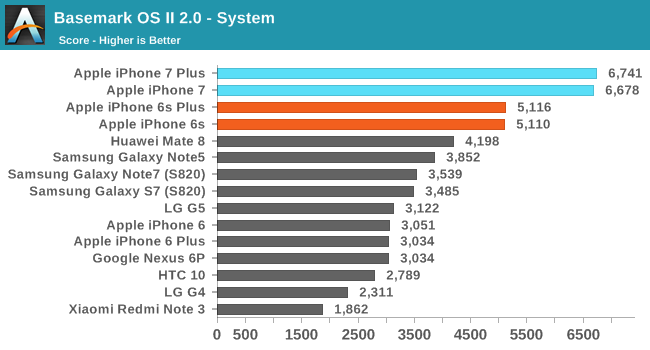
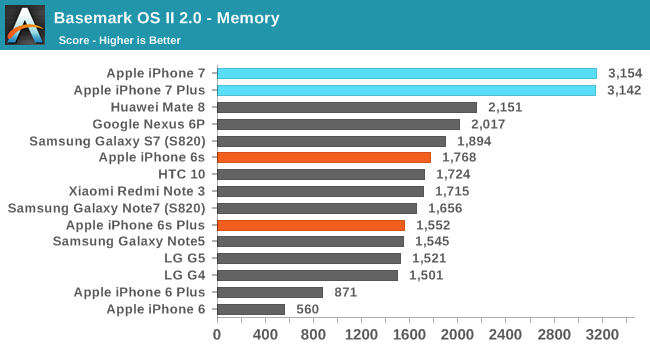
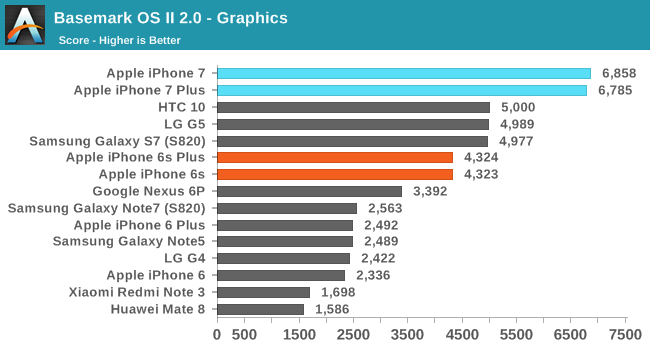
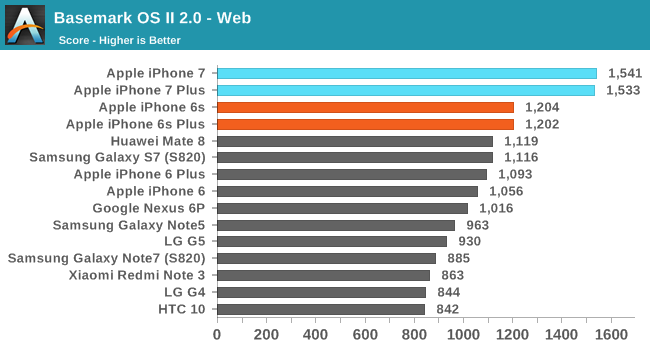

I've brought back BaseMark OS II for this review, although unfortunately the reason has less to do with wanting it back in the benchmark suite and more to do with there being very few cross-platform general system benchmarks nowadays. You can focus on the GPU, or the CPU, but the major system performance benchmark in mobile is PCMark and it remains exclusive to Android. BaseMark OS II is a pretty large optimization target now, and while it does test many aspects of the system it doesn't do so by directly simulating the tasks that a user would perform. Despite that, it helps in getting a holistic view of a device's performance by going beyond tests of a single component, so it's not without its uses.
The iPhone 6s and 6s Plus have remained the fastest overall devices in this test, so it's really just a matter of seeing how much Apple has improved. The latest generation of Android devices outpaced the GPU performance Apple's A9 SoC some time ago, so that's one area where Apple could stand to improve against the competition. As it turns out, they have. The iPhone 7 and 7 Plus show significant gains over their predecessors across the board. Performance in the system sub-test is up by 25-30%, and the graphics score is right in line with Apple's claimed 50% increase in performance. Web shows similar gains to system, which makes sense given that both are relatively CPU-bound.
The memory/storage test also shows a large improvement, which is interesting at first glance given that Apple didn't highlight any improvements in this area. However, this is just the result of the tested units being the 256GB model. On my retail iPhone 7 which is 128GB the memory score is essentially the same as the iPhone 6s which was also tested in a 128GB configuration. This comes down to the fact that these devices use a hybrid SLC/TLC storage solution, where the SLC storage can be used for writes and data can be moved later as needed. It's likely that on the 128GB iPhones the BaseMark OS II memory test is exceeding the size of the SLC cache, leading to lower scores based on the performance of the TLC NAND. On the 256GB iPhone the SLC cache is large enough to fit the entire data set used in the test, leading to a much higher score.
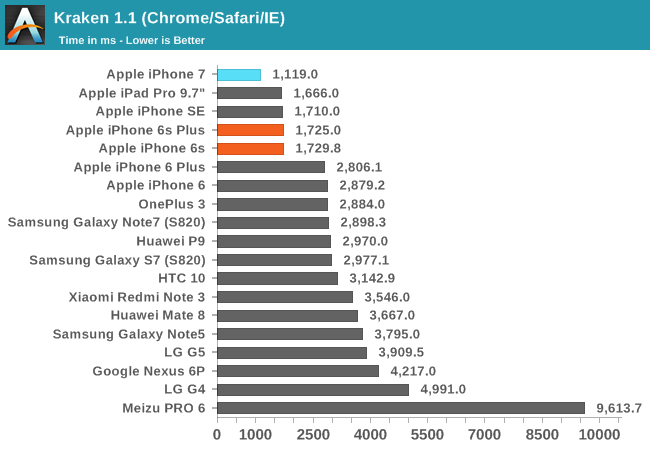
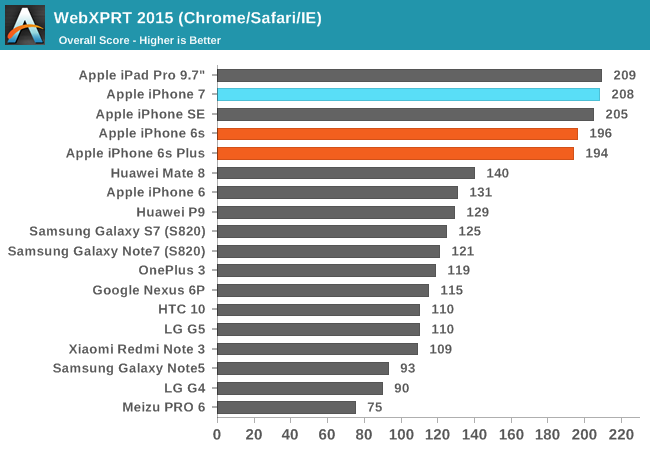
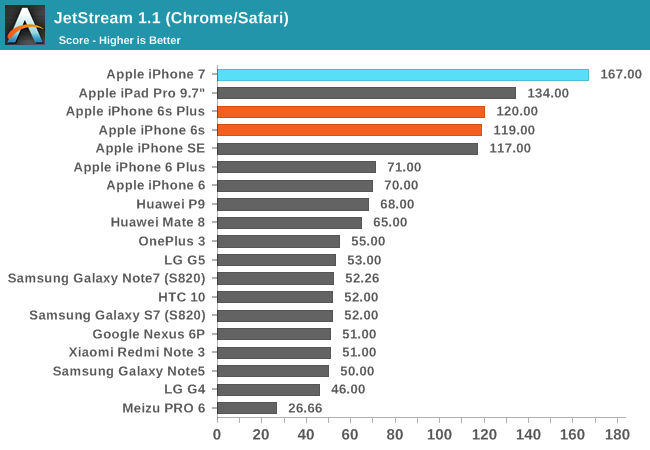
Web performance is an interesting case. While Apple's continued increases in single core CPU performance have benefited web performance with each generation, the truth is that improvements Mobile Safari's Nitro JavaScript engine have contributed a great deal as well. When looking at the charts you can see that there's a significant gap between the iPhone 7 and the next device, with the exception of WebXPRT where it's tied. What's more important than this gap is what the second device actually is. It's always another Apple device, and the same is true for the third device, and the fourth device, and so on. In Kraken and Jetstream the top seven devices on the chart are Apple's mobile devices, and the charts only have seven Apple devices in total. The Huawei Mate 8 is able to move ahead of the iPhone 6 in WebXPRT, but the gap between it and the iPhone 6s is still enormous. While Apple has continued to advance their web performance, it hasn't been with the immediate goal of beating the Android competition, as the best Android devices are still just trading blows with the iPhone 6.
WebXPRT is a small exception. As far as mobile benchmarks go, it's quite long and has short bursty workloads with pauses between each to simulate how a user would pause between different actions while using the browser. I suspect that in this case we're seeing the effects of A10 switching between its low power and high performance cores, causing parts of the test to be run on the little cores, which are not as performant. In fact, In the case of very quick actions that take only tenths or hundreths of a second to complete, it may not be possible to switch to the high performance cores before the operation has ended, causing the score to reflect the performance of the low power cores instead.
While it might seem reasonable to attribute the superior web performance of iOS devices to Apple's focus on improving single threaded CPU performance, the fact that Android devices with Cortex A72 CPUs are only matching Apple's A8 SoC shows that the gap is not only due to the CPU power available. Chrome's generally poor performance on Android is a significant limiting factor, and you can see in the chart how the improvement in Android device CPU performance over time has not translated into anything close to the sorts of gains that Apple has seen in the same period. While there are customized versions of Chromium like Snapdragon Browser that provide optimizations for a class of SoCs, it doesn't look like the gap between Android devices running Chrome and iOS devices running Mobile Safari is going to close any time soon, and if anything, it's only widening with each year.


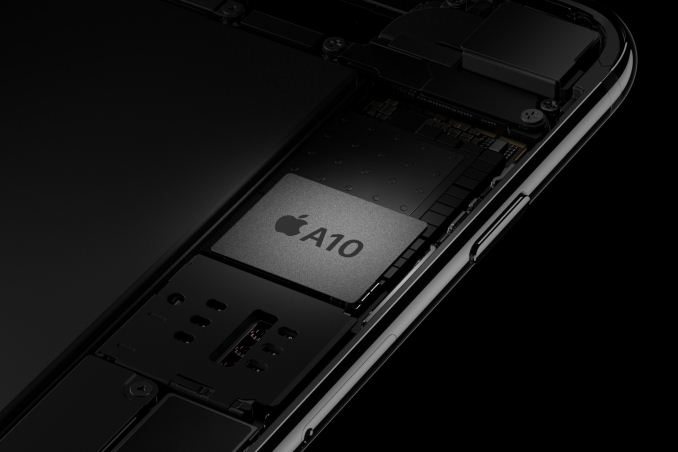








377 Comments
View All Comments
solipsism - Monday, October 10, 2016 - link
The 3" adapter has a very firm fit on your 3.5mm headphones; more so than your typical headphone jack on a smartphone. I'm sure this is intentional to help keep it in place.As mentioned in the article, wireless is the future, and while I've been using BT headphones for years now, my current ones (Bluez Aftershockz 2) finally broke so I'm using wired headphones until I the other headphones with Apple's W1 chip hit the market. I'm leaning toward the BeatsX as I prefer in-ear, and the connected cable, but I'm willing to give the AirPods a chance since so many are saying they are more comfortable than their included EarPods, which I find to be uncomfortable.
I've noticed that my wired headphone cable doesn't get tangled as easily and is easier to plug into my iPhone. I attribute this to both the slightly extra weight and thickness of the connector. I'd rather not be wired at all, but the adapter certainly hasn't been an issue. Since I only charge my phone once a day or every other day, this repeated claim that everyone needs to charge and listen to wired headphones as the same time escapes me. I'm guessing it's one of those invented problems only a few people actually need
greyhulk - Monday, October 10, 2016 - link
I hope you address thermal throttling in the deep dive. That's what I'm most interested in with the new A10.SydneyBlue120d - Monday, October 10, 2016 - link
While I really hope to see AV1 2160p60 with multichannel audio encoding with iPhone 8, I'd like to read a test comparison between Intel and Qualcomm modem, especially with Europe networks :) Thanks a lot.i4mt3hwin - Monday, October 10, 2016 - link
"Overall, the iPhone 7 and 7 Plus remain the best phones on the market for video capture. Strange issues with Snapdragon 820 video encode blocks mean that all Snapdragon 820 devices are just barely passable for video capture."I don't recall seeing this anywhere? I Know the OP3 article mentioned that the video was blocky - but I don't remember it linking that to the 820 - just a OP3 implementation issue? Does this mean the Pixel is going to experience similar issues?
grayson_carr - Monday, October 10, 2016 - link
I can confirm that my S7 Edge has this issue, and it's bad. When I first got it, I recorded a couple 4k videos while hiking along an oceanside trail and the blocky artifacts in the water and sky looked so crappy that I just never recorded videos with it again. It was technically 4k video, but it looked more like a 360p YouTube stream with the amount of blockiness, especially when panning up and down.lolipopman - Tuesday, October 11, 2016 - link
Why was this issue not explored by Samsung? I'm pretty sure it's not common or else it would've been known.lilmoe - Monday, October 10, 2016 - link
You do realize that the shutter speed on the iPhone's night images is twice as long as the others using lower ISO values, right?You call this "impressive"? I highly recommend a primer in photography.
JoshHo - Monday, October 10, 2016 - link
The exposure time of 1/4s is not indicative of all exposures. I would reference the iPhone 6s and 6s Plus reviews to better understand how Apple handles low light to avoid motion blur despite long exposures.lilmoe - Monday, October 10, 2016 - link
Yea, I've seen that review.Might I also suggest a primer in videography. Here's how a the video review portion should look like, and what it should include/test:
https://www.youtube.com/watch?v=4YCvLW2ySr0
Listen, I don't mean to insult you or anything, but you need to know that your criteria is fundamentally flawed. In addition to the objective truth that Samsung, and others, have the superior video (and audio), their image processing is what PEOPLE WANT. You give customers what they want, not what you think is best, especially for a mainstream product (ie: non-professional). If you want to compare sensor/lens quality, you compare RAW images using the same settings (but you didn't, for reasons).
Smartphone photography is about USABLE images/footage. You just don't apply the same criteria you do when reviewing a DSLR/DSLM.
Stop marketing "true colors" (which aren't exactly true, btw) for a crowd of users that apply filters to everything they post online.
Admit, correct and move on.
grayson_carr - Tuesday, October 11, 2016 - link
Samsung? Superior video? LMAO. Go home. You're drunk. I almost took you seriously until you said that out loud. -Galaxy S7 Edge owner